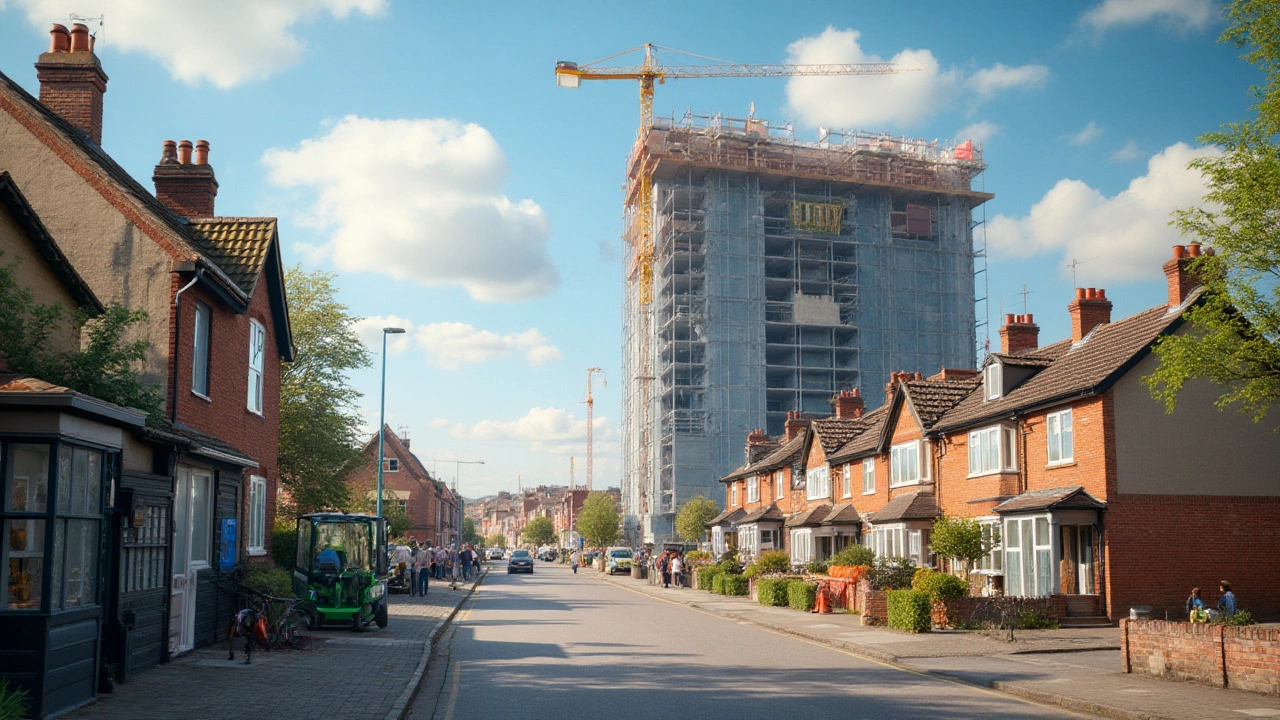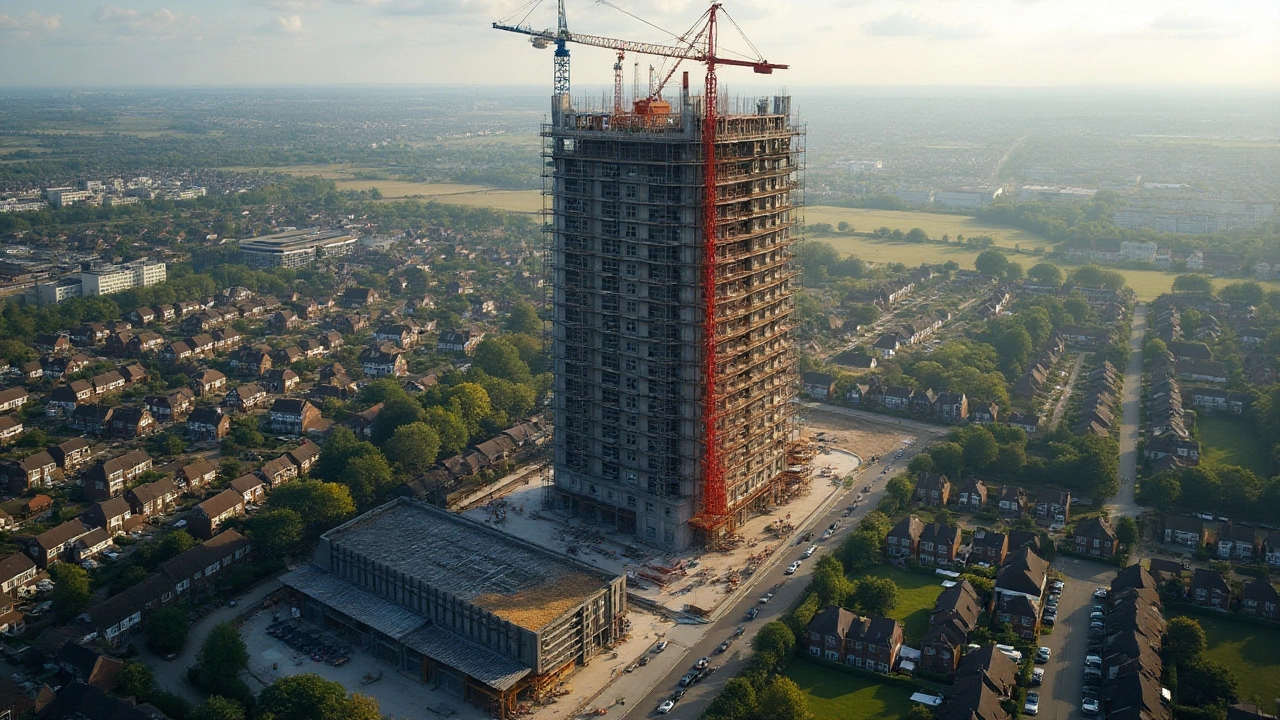In the world of construction, the divide between commercial and residential projects is substantial, each presenting unique challenges and demands. While both function to create functional spaces, they cater to vastly different needs and purposes.
Commercial construction projects range from office buildings to shopping centers, designed to serve the public. Residential projects, on the other hand, focus on individual living spaces, crafting homes that cater to personal comfort and style. These differences extend beyond mere structure, affecting project timing, budgeting, and regulations that must be adhered to.
Understanding these variations is crucial for anyone involved in the construction industry, as each type calls for specific expertise and strategic planning. As we explore the defining traits of commercial and residential constructions, we'll uncover practical insights and strategies to aid professionals in effectively managing these distinct project types.
- Scope and Purpose
- Design and Materials
- Regulations and Codes
- Budgeting and Scheduling
- Impact on Communities
- Tips for Construction Professionals
Scope and Purpose
Understanding the differences in scope and purpose between commercial construction and residential projects is essential. Commercial construction focuses on creating spaces for business-related activities, such as offices, retail stores, hotels, and factories. These projects are typically larger in scale, designed to accommodate large groups of people, and must adhere to commercial building codes. Residential construction, on the other hand, is about crafting personal living spaces, like single-family homes, apartments, or condominiums. The intent behind a home is deeply personal, with attention given to aesthetics, comfort, and lifestyle preferences of individual occupants.
One of the main differences also lies in the driving forces behind these projects. Commercial buildings are generally shaped by economic and organizational objectives. They might include elements such as state-of-the-art facilities, sustainable building practices, or technological integration to streamline business operations. These considerations often result in sophisticated designs and materials that can support more intensive use compared to those in residential settings. Residential projects, converse, prioritize creating spaces where individuals and families can thrive in comfort and style. This means more customization options in layout, interior design, and energy-efficient solutions tailored to personal tastes.
A significant aspect of commercial construction projects is their flexibility and functionality. Unlike homes, commercial spaces should be designed for adaptability to meet various business needs as they evolve over time. It is common for office buildings and retail spaces to undergo renovations and retrofits to suit new tenants or comply with updated regulations. In contrast, residential buildings are primarily designed for long-term occupancy with fewer drastic changes. While these homes might experience remodels or extensions, their core design remains more static compared to commercial buildings.
The scope of these projects also extends to financing and project planning. Commercial constructions are often funded through corporate investments or business loans, with an emphasis on maximizing return on investment (ROI). They may involve complex financing strategies to manage the significant capital involved in large-scale developments. Residential projects rely more heavily on personal loans or mortgages, with budget considerations more closely tied to individual financial capabilities. This means shorter construction timelines and cost constraints in the residential sphere compared to potentially prolonged schedules in the commercial sector.
"In commercial construction, we don't just build structures; we build environments that drive business forward. Our purpose is to create spaces that inspire innovation and growth," says James Henderson, a renowned commercial architect.
To ensure success, both commercial and residential constructions require strategic planning. Businesses must identify their target demographic and envision spaces that cater to their specific requirements while efficiently utilizing space and resources. Meanwhile, homeowners seek a tailored approach, balancing their immediate needs and prospective plans within budgetary limitations. The intricate balance between cost, functionality, and design is critical in all construction projects, ultimately defining the character and purpose of each space.
Design and Materials
When it comes to the realm of construction, the elements of design and materials play a pivotal role in distinguishing commercial construction from its residential counterpart. The objectives of these designs are often aligned with the intended function these structures will serve. In a commercial construction setting, materials are chosen with durability, functionality, and cost-efficiency at the forefront. Steel, concrete, and glass dominate the landscape, each chosen for its ability to withstand heavy usage and their aesthetic appeal when creating expansive spaces or skyline-defining structures. Leather or high-quality fabrics don't just adorn lobbies but are chosen for their robustness in daily wear-and-tear environments.
On the other hand, residential projects are designed with comfort and personal aesthetic in mind, focusing on more homely materials such as wood, brick, and plaster. These are selected for their ability to provide warmth and insulation, making houses more energy-efficient and inviting. The tactile interplay of these materials in homes can lead to myriad styles, from rustic coziness to sleek modernism, depending on the preference of the homeowner. Often, residential designs embrace sustainability with the use of eco-friendly materials, especially prevalent in recent constructions aiming for energy efficiency and reduced environmental impact.
In the commercial sector, the design often seeks to balance functionality with an impressive aesthetic that resonates with brand identity or corporate ethos. This is epitomized by the use of glass facades which not only allow for natural light but also present a modern, progressive image to the outside world. "A well-thought-out commercial space is not just about providing shelter but cultivating an environment conducive to productivity and client engagement," notes architect Sarah Lancaster of BrightSpaces Group.
"In commercial design, you aren't just building structures; you're crafting experiences and interactions unique to the business's ethos," she explains.
An interesting consideration is the difference in timelines tied to materials used. Commercial projects often run on stricter timelines due to the nature of business demands and leasing commitments, which impacts material choice. Prefabricated materials may be employed to expedite the construction process without sacrificing quality. These materials not only speed up construction but also ensure adherence to stringent safety and health regulations that are mandated more rigorously than in private residential builds. The choice of such materials can be crucial in financial planning stages, directly impacting the budget allocations and projected profitability of the project.
Material Innovations in Commercial Construction
Notably, the construction industry in commercial settings is increasingly experimenting with new materials and technologies. From the use of smart glass that adapts to light changes, enhancing energy efficiency, to advances in sustainable concrete with lower carbon footprints, the material world is adapting rapidly. A survey conducted in 2023 by the Global Construction Review highlighted that 68% of commercial builders are now incorporating green materials as part of their standard operations.Design and materials don’t just impact the aesthetic or the physical durability of a construction project. They shape the very essence of the space and influence the inhabitants' experience and the sustainability footprint. As both sectors continue to evolve, understanding these distinctions in design and material use is crucial for anyone keen to make informed decisions in the realm of construction.

Regulations and Codes
The stark difference in commercial construction and residential projects often lies in the layers of regulations and codes that each necessitates. Both areas must adhere to strict guidelines, but the rules for commercial construction are significantly more intricate and demanding. These codes exist to ensure the safety and operational efficiency of buildings, particularly since commercial spaces house more people and have varied uses that range from retail to industrial purposes. In contrast, residential regulations are often centered around safety and well-being for a smaller group of inhabitants.
Building codes for commercial construction are meticulously detailed to address diverse functions. A commercial space could be an office one day and be transformed into a restaurant the next. This fluidity demands a comprehensive approach to regulations from fire safety and accessibility to energy efficiency standards. Residential codes, while strict, are more focused on parameters such as structural integrity and environmental considerations like insulation.
Renowned engineer Henry Petroski once noted,
"Codes and engineering specifications are not a matter of opinion. They are hard facts."His insight sheds light on the importance of adhering to such codes, which are often revised in response to evolving safety standards and technological advancements. In the UK, for example, the Building Regulations set out minimum standards for design, construction, and alterations to virtually every building. These regulations are subject to amendments, and professionals must stay updated with the latest versions to remain compliant.
Understanding how the regulations differ is vital for smooth project execution. Each country and even regions within countries have tailored codes. One might think commercial spaces predominantly follow global benchmarks, which they often do — the International Building Code (IBC) and the European standards (EN) are guides for many commercial projects. However, local exceptions always apply, emphasizing the critical need for local expertise in the planning stages.
For anyone embarking on a commercial construction project, here are some tips to navigate the labyrinth of codes effectively:
- Thoroughly research the specific codes relevant to your project type and location.
- Engage the services of a local expert who is familiar with regional amendments and requirements.
- Implement a regular review system during the design phase to ensure compliance.
Budgeting and Scheduling
When diving into the world of commercial construction, budgeting and scheduling stand out as pivotal components that can make or break a project. The complexities involved in managing these aspects cannot be overlooked because commercial projects generally have a more significant scale than residential projects. With stakes running high, meticulous planning becomes crucial. Budgets in commercial settings often stretch into the millions, requiring comprehensive understanding of resource allocation and forecasting. Costs for materials, labor, permits, and unexpected contingencies pile up, demanding sharp acumen in fiscal management. To illustrate, many developers rely on sophisticated financial modeling software to simulate potential financial scenarios prior to breaking ground.
The scheduling side of things is equally daunting. Commercial timelines are unforgiving, with investors and stakeholders monitoring every milestone. Construction delays can lead to significant financial penalties and loss of potential revenue. Commercial projects often involve multiple phases, and detailed Gantt charts or critical path methods (CPM) are used to ensure each phase is completed on time. Many project managers adopt Agile methodologies, allowing for dynamic adjustments and stress-tests for various timelines.
Key Aspects of Effective Budgeting
- Comprehensive cost estimation
- Risk management strategies
- Strong vendor and subcontractor relationships
- Adaptive financial forecasting tools
Residential projects, while typically on a smaller scale, approach budgeting and scheduling with a different lens. The personalization aspect in residential construction dictates that while budgets may appear smaller, customization pushes intricacies, promoting a need for accuracy in cost estimation for non-standard materials and features. Scheduling is more flexible; however, delays can affect resident occupancy plans, which poses its own set of challenges. In a quote from a leading construction management firm in a publication, it was noted:
"Effective budgeting goes beyond number-crunching. It's a balancing act of cost vs. value, predicting market shifts, and leveraging technology for data-driven decisions."Understanding these nuances between commercial and residential timelines is essential for tailoring efficient strategies for both project types. Whether it's the looming pressure of a grand shopping mall's opening or the intimate endeavour of building custom homes, getting it right on budgeting and scheduling is key to a project’s success.

Impact on Communities
The implementation of commercial construction projects can significantly reshape a community, influencing everything from local economies to social dynamics. When commercial spaces such as malls, offices, or industrial hubs sprout, they introduce a whirlwind of change. They foster job creation, not only through the immediate need for construction workers but also for the businesses that occupy these new spaces. Local stores may see increased foot traffic, while new businesses may lure more residents into the area seeking employment opportunities, breeding a vibrant local economy around the project.
However, with prosperity comes challenges. Communities might face issues concerning urban congestion, noise, and pollution. There is often a debate between the need for economic growth and the preservation of community character and lifestyle. According to the UK Green Building Council, "Development in urban areas should strive towards sustainability while enhancing the quality of life for residents." This means that developers should consider eco-friendly designs and advanced waste management solutions to minimize environmental footprints.
| Positives | Negatives |
|---|---|
| Job opportunities | Increased congestion |
| Economic growth | Environmental concerns |
In contrast, residential projects have their unique impacts. They directly cater to increasing housing demands, which can stabilize or even decrease local property prices by supplying more options. This form of construction tends to resonate well with the idea of community, emphasizing local character and often revitalizing areas by converting derelict lands into thriving neighborhoods. As families settle, they bring stability and growth to local schools, businesses, and public services, inherently stitching the community fabric tighter.
Yet, housing developments sometimes draw skepticism. Concerns about overcrowding, strain on local resources, and infrastructure are pivotal discussion points. Thoughtful planning and comprehensive community engagement are crucial, allowing for a balanced integration of new homes that align with the community's long-term vision and sustainability goals. With the growing emphasis on sustainable urban living, innovative approaches are being adopted to harmonize residential growth with environmental stewardship, often involving community input to ensure projects meet communal needs.
Ultimately, the art of balancing these impacts comes down to strategic planning and community collaboration, where open dialogues and transparent planning processes can turn potential tensions into alignments for mutual growth and prosperity.
Tips for Construction Professionals
Construction professionals, whether diving into commercial construction or residential projects, need to hone particular skills and strategies to thrive in their respective fields. A major tip is staying informed about the latest materials and technologies. The construction landscape is constantly evolving with innovations such as smart building systems and sustainable resources offering advantages for modern projects. Keeping up with these new developments can not only improve construction quality but also boost efficiency and cost-effectiveness. Attending industry conferences and subscribing to credible journals and newsletters can serve as excellent resources for staying updated.
Understanding regulations is another crucial aspect. In commercial projects, regulations can be more intricate due to the different public use and local business impact. Navigating these regulations requires meticulous attention to zoning laws, building codes, and accessibility standards. A keen understanding of these elements ensures that projects are not stalled by compliance issues, allowing for smoother progression and preventing costly delays. Royal Institution of Chartered Surveyors notes,
"Adhering to regulatory frameworks not only assures compliance but enhances project credibility and stakeholder trust."
Another indispensable tip is mastering the art of budgeting and scheduling. In both commercial and residential contexts, financial management plays a pivotal role. Professionals need to develop detailed cost plans and timelines that account for contingencies and market fluctuations. Effective budgeting techniques involve regular financial audits and using project management software to manage resources and timelines efficiently. Skills honed in this area can be the difference between a profitable venture and a fiscal blunder.
It's also vital to appreciate the role of impactful communication. Construction projects often involve collaboration among diverse teams, from architects and engineers to clients and subcontractors. Communicating effectively across these different levels, ensuring everyone shares the same vision and objectives, can significantly contribute to a project's success. Holding regular project briefings, using visualization tools, and nurturing a culture of open dialogue helps address concerns promptly and keep the team aligned with goals.
Lastly, one should never underestimate the power of networking. Building solid relationships within the industry can open doors for lucrative opportunities. Cultivating ties with suppliers, contractors, and industry leaders fosters a thriving professional environment where resources and knowledge are shared, paving the way for growth and innovation. Be sure to attend local construction meetups, engage in professional organizations, or even partake in digital communities to expand one's network. Incorporating these tips could undoubtedly strengthen one's career path in the ever-demanding construction industry.
